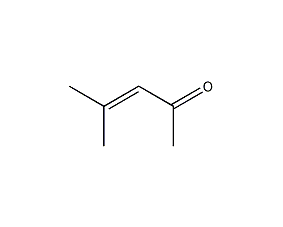
Structural formula
| Business number | 03UB |
|---|---|
| Molecular formula | C6H10O |
| Molecular weight | 98.14 |
| label |
4-methyl-3-penten-2-one, methylpentenone, isopropylene acetone, Mesopropylidene acetone, 4-Methyl-3-pentene-2-one, Methyl amyl ketone, Isopropenyl acetone, Mesityl oxide, thinner, Strong solvent with medium boiling point, paint stripper |
Numbering system
CAS number:141-79-7
MDL number:MFCD00008900
EINECS number:205-502-5
RTECS number:SB4200000
BRN number:1361550
PubChem number:24856998
Physical property data
1. Properties: Colorless or light yellow oily liquid with a honey-like odor.
2. Boiling point (ºC, 101.3kPa): 129.7
3. Melting point (ºC): -52.8
4. Relative density (g/mL, 20/4ºC): 0.8584
5. Relative density (g/mL, 60/4ºC): 0.81834
6. Relative vapor density (g/mL, air=1): 3.38
7. Refractive index at room temperature (n20): 1.4441
8. Viscosity (mPa·s,0~40ºC): 0.839~0.512
9. Flash point (ºC): 32
10. Fire point (ºC): 350
11. Heat of vaporization (KJ/kg, 20ºC): 433.1
12. Specific heat capacity (KJ/(kg·K), 21~121ºC, constant pressure): 2.18
13. Critical temperature (ºC): 330
14. Critical pressure (MPa): 3.55
15. Vapor pressure (kPa, 26ºC): 1.33
16. Volume expansion coefficient (K-1,55ºC): 0.00112
17. Solubility: Miscible with various organic solvents such as ethanol, ether, acetone, aromatic hydrocarbons, heptane, carbon tetrachloride, etc. . It has strong dissolving ability for cellulose esters, cellulose ethers, greases, polystyrene, ethylene copolymers, hydrocarbons, kauri, resin, glycerol trirosinate, rosin, synthetic rubber, etc. It dissolves 2.8%~3.1% in water at 20℃; water dissolves 3.1%~3.4% in isopropylene acetone. It can form an azeotropic mixture with water, with an azeotropic point of 91.8°C. The azeotropic mixture contains 65.2% of mesityl oxide.
18. Refractive index at room temperature (n25): 1.4414
19. Relative density (25℃, 4℃): 0.7602120
20. Critical density (g·cm-3): 0.278
2Preparation method: Isopropylacetone is produced by dehydration of diacetone alcohol. Due to its active chemical nature, it often contains impurities such as acidic substances and condensation polymers. The general refining method is drying with anhydrous sodium sulfate and then distilling.

2.
Preparation method:
Diacetone alcohol (3): Add 660mL (9mol) of acetone (2) to the Soxhlet extractor, and wrap the hydrogen in the extraction tube of the Soxhlet extractor with filter paper Barium oxide, heated in a water bath and refluxed for 100 hours. Change to a distillation device, first steam out the acetone, then distill under reduced pressure, collect the fraction at 62~64°C/1.75kPa, and obtain 370~410g of diacetone alcohol (3), with a yield of 68%~74%. Mesopropylene oxide (1): In a round-bottomed flask equipped with a fractionation device, add 350g (6mol) of diacetone alcohol (3), 0.1g iodine, and a few grains of zeolite, and heat in an oil bath for distillation. Collect the following fractions: the fraction below 85°C (contains acetone and a small amount of mesityl oxide); the fraction between 85 and 126°C (contains water and mesityl oxide, which can be separated into layers after standing, and the lower layer is water); Fraction at 126~130℃ (mesopropylene oxide). The middle fraction is dehydrated and dried with anhydrous potassium carbonate. After being combined with the third fraction, it is re-distilled and the 127-129°C fraction is collected to obtain mesityl oxide. The first fraction is dried with anhydrous potassium carbonate and re-distilled to obtain a small amount of mesityl oxide. A total of 250 to 280 g of mesityl oxide (1) was obtained, with a yield of 85% to 95%. [1]
Purpose
It is a strong solvent with medium boiling point. The evaporation rate is between acetone and diacetone alcohol. Together with isophorone, it can be used as a low-viscosity diluent for nitro spray paint, a solvent or paint remover for vinyl resin, rubber and cellulose ester coatings, dyes and inks. Also used in the manufacture of insect repellents, mineral flotation agents, etc.

 微信扫一扫打赏
微信扫一扫打赏

